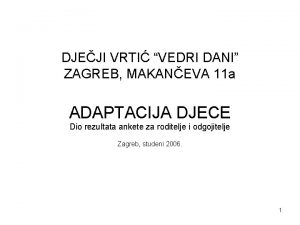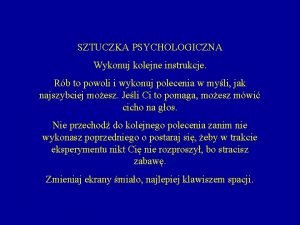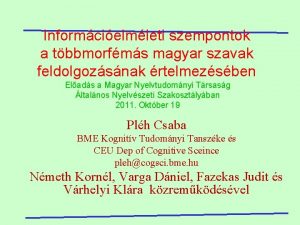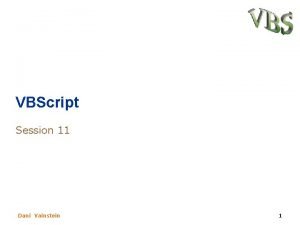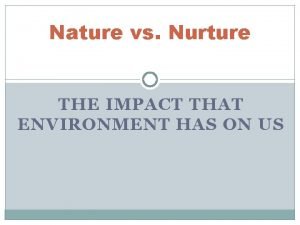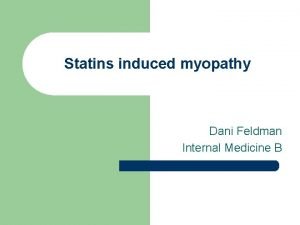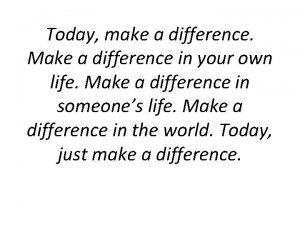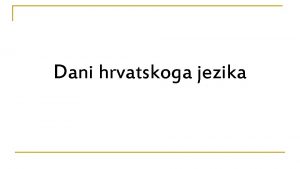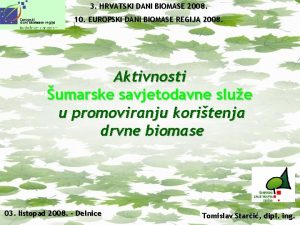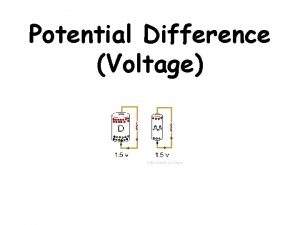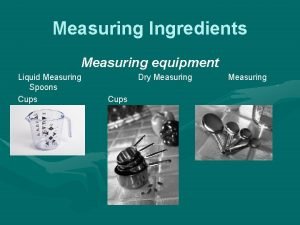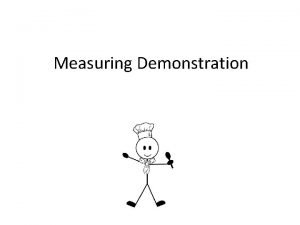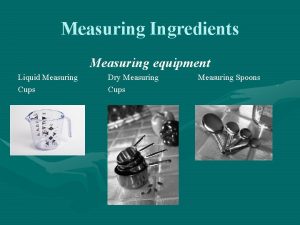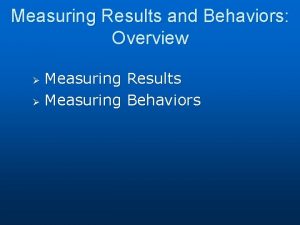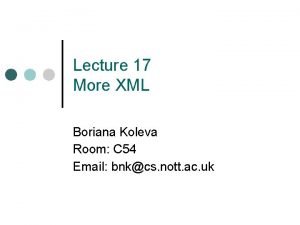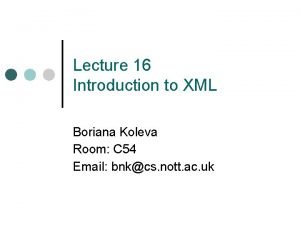Measuring the difference we make Dani Koleva 10

























- Slides: 25

Measuring the difference we make Dani Koleva, 10 June 2015

The context The Programme was aimed to close a home for children from 3 -7 years old through development of a range of services including: • Prevention of abandonment; • Supporting reintegration to birth family, kinship care and adoption; • Development of foster care and • A Small group home service (capacity 8 children).

The Philosophy: core principles and approaches The main principles embedded in the system were: • Reliability; • Validity; • Objectivity; • Quality and • Transparency.

Two main approaches • Results – based and • Participatory.

Summary of the model: - Overall programme progress – how preventative and alternative services developed and were taken up and - Changes in children – measuring the impact of the de-I on children who left institutional care and were placed in family or community-based alternative care.

Overall programme progress: two key indicators: • The number of children placed in alternative services and • The number of children prevented from being abandoned and/or institutionalized.

Overall programme progress: two key indicators: • The number of children placed in alternative services and • The number of children prevented from being abandoned and/or institutionalized.

Prevention key indicators: • Newly opened cases • Cases underway (on-going) • Successfully closed cases – children stayed with their families after the 12 months monitoring • Unsuccessfully closed prevention cases – children placed in institutions • Children placed in FC or Mother and baby unit –work still continues.

FC key indicators: • General public reached through information meetings • Enquiries to the FC team • Applications received • Households who completed training • Approved FC households and • Children placed and placements supported. ? Children who have been moved more than 2/3 times for the last 12 months?

SGH key indicators: • No. of new children placed • Children currently resident • Alternative placements from SGH – re-i, adoption or FC • Children who have contact: -No contact at all -Frequent (more than once a month) -Occasional (once or several times per year) -Children who have overnight stay with their family. • Children who have been hospitalized.

Child development assessment tool (CDAT): Purpose: to assess and measure the development of children aged: 0 -1 1 -3 3 -7 and 7 -11 years old. Services: re-i with biological or extended family, placed in FC or SGH from institutional care. ! Not used for prevention cases including placement in FC from birth/extended family given that these children have not been institutionalized.

Domains, categories and indicators: 4 domains – broad areas of development: physical, intellectual, social and behavioral: • Physical refers to the ability of the child to undertake activities using motor skills, including self-care. • Intellectual refers to the ability of the child to understand, think, memorise information and be able to make and use judgements. • Social refers to the ability of the child to interact with others (peers and adults) within and outside the home environment. • Behavioral refers to the ability of the child to act and express him/herself.

Domains, categories and indicators: Each domain comprises a number of categories and Each category comprises a number of indicators who were developed in consultation with child development experts, social workers and carers.

Example from the Social domain: Category: Indicators: Interactions with other children Plays well with others, during pretend play Takes turns and shares Lots of complex play on his/her own and with peers, using more and more imagination Argues more constructively Does not engage in sexual play with other children

Example from the Social domain -2: Category: Indicators: Interaction with adults Rude with adults when cross Likes to show off skills to adults Will test authority in an appropriate way Does not become anxious and clingy when caregiver wants to go out without him/her Is not overly friendly with strangers (not talking to or touching people inappropriately in public places) Initiates interactions with adults appropriately Seeks comfort from adult caregivers Demonstrates age appropriate behaviour in public

A Four Point Rating Scale: Descriptors Rating Not applicable to the child being assessed N/A Shows severely delayed development for age 1 Shows some delayed development for age 2 Shows average development for age 3 Shows above average development for age 4 All the CDATs have rating guidelines for the specific age group.

Using the CDAT tool – an example: Domain: Category: Indicator: Physical Gross motor skills “Can hop on one foot repeatedly” Hopping on one foot is something that we would expect a child to be able to do by the time he/she is 4 -5 years old. Therefore, when rating:

Using the CDAT tool – an example -2: • If the child is aged 4 -5 and can do this, he/she is showing average development and will be rated 3. • If the child is aged 4 -5 and cannot yet do this, he/she is showing some delayed development and will be rated 2. • If the child is older, above 5 years, and cannot yet do this, he/she is showing severely delayed development for the age and will be rated 1. • If the child is older, above 5 years and can do this, then this is expected and is not relevant to the assessment and will be rated N/A. • If the child is younger, below 4 years, and can do this, then he/she is showing above average development for the age and will be rated 4.

The complete CDAT: In addition to domains, categories and indicators, each CDAT kit includes: - a standard Child Profile form with key information such as child’s date of birth, gender, siblings, medical condition and the child’s placement history -a standard Child Development Assessment Manual which cover all CDATs and explains how the assessments are to be carried out - age specific Rating Guidelines for each CDAT.

The complete CDAT: A. General materials relevant to all age groups: Standard Child Profile Child Development Assessment Manual B. Age specific child development assessment tools: - Child Development Assessment Tool 0 -1; 1 -3; 3 -7; 7 -11 years old - Rating guidelines for CDAT 0 -1; 1 -3; 3 -7; 7 -11 years old - Excel calculator for the data entering and analysis.

Who does the assessment: Interviews with, and observations of, the children, and the subsequent rating, should be completed by the social worker working on the particular case who knows the child best. Ideally, the assessment team should comprise of two social workers or child psychologists in order to ensure minimal bias in the ratings and to complete the assessment process in a short time. It is possible for one social worker or psychologist to conduct the assessment. The decision depends on the resources available for the assessment.

How often are assessments conducted: The first assessment measures the development of the child at a point in time. This provides baseline data which serves as the point of comparison for subsequent assessments. Second and subsequent assessments allow for change to be measured over time to confirm the premise that de-institutionalisation and placement in alternative care services supports child development and can help counter the negative developmental effects of institutionalisation. Assessments should be completed at 9 -12 months intervals.

How are the assessments conducted: The Child Profile will be completed by the CPD social worker working on the child’s case and ideally this should be done in advance of each assessment. The interviewer/s should allow at least three hours for an assessment. The key informants of the assessment are the child, the care giver(s) and teachers. Two information gathering methods and techniques should be used – observation and interviewing, the extent to which the latter is used directly with the child clearly depends on their age and developmental stage.

The results?

THANK YOU FOR THE ATTENTION!
 Boriana koleva
Boriana koleva Go make a difference we can make a difference
Go make a difference we can make a difference Dani u nedelji na italijanskom
Dani u nedelji na italijanskom Dani u nedelji italijanski
Dani u nedelji italijanski Dani connor
Dani connor Funkce daní
Funkce daní Slidetodoc.com
Slidetodoc.com Dv vedri dani
Dv vedri dani Dani vargas huanca
Dani vargas huanca Dani sustainable leather
Dani sustainable leather Tribu de daniel
Tribu de daniel Niebieskie irysy w danii
Niebieskie irysy w danii Dani suandi
Dani suandi Dani suandi
Dani suandi Dani+jel+jel+rag
Dani+jel+jel+rag Dani bernard
Dani bernard Dani bailey
Dani bailey Dani su čovjekovi kao sijeno
Dani su čovjekovi kao sijeno Dani
Dani Dani malina skrad
Dani malina skrad Tushar broadband
Tushar broadband Dani lierow
Dani lierow Dani
Dani Amiadarone
Amiadarone Prilozi u italijanskom jeziku
Prilozi u italijanskom jeziku Dani christensen
Dani christensen







